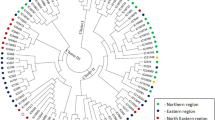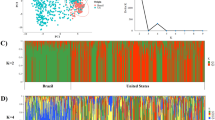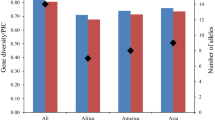Summary
135 soybean landraces and pure line selections from Kyushu district fo Japan were assayed for isozyme and seed protein loci in order to determine the genetic structure groups of summer and autumn maturing cultivars. Out of the 16 tested loci, Dial, Enp, Estl, and Ti exhibited a marked difference in allelic frequency between both groups. The summer cultuvar groups had a high frequency for Dial-b, Enp-b, Estl-a and Ti-b, whereas Dial-a, Enp-a, Estl-b, and Ti-a were predominant in the autumn groups. The analysis of multi-locus genotypes revealed that both groups mostly consisted of different multi-locus genotypes. The allelic combination Dial-b Enp-b Estl-a Ti-b was most frequently observed in the summer cultivars, whereas four genootypes, Dial-a Enp-a Estl-a Ti-a, Dial-a Enp-a Estl-b Ti-a, Dial-a Enp-b Estl-b and Dial-a Enp-a Estl-b Ti-b, occupied most of the autumn cultivars. These results indicated that both groups were appreciably differentiated from each other. The summer cultivar groups also included a few accessions having the multi-locus genotypes observed predominantly in the autumn groups or Acol-b charcteristic of the landraces native to northern Japan. It seems likely that the summer cultivar groups was not phyletically derived from a single common ancestor, but partly involves the landraces with early maturity derived from northern Japan. Dial, Enp, Estl and Ti are useful genetic markers ot trace the origin and dissemination paths of Japanse soybean landraces.
Similar content being viewed by others
References
Abe, J., M. Ohara & Y. Shimamoto, 1992. New electrophoretic mobility variants observed in wild soybean (Glycine soja) distributed in Japan and Korea. Soybean Genet. Newsl. 19: 63–72
Butt, C.J. & Y.T. Kiang, 1989. Inheritance and genetic linkage test of an esterase locus in the cultivated soybean, Glycine max. J. Hered. 80: 82–85.
Carlson, J.B. & N.R. Lersten, 1987. Reproductive morphology. In: J.R. Wilcox (Ed.) Soybeans: Improvement, Production, and Uses, pp. 95–134.
Fukui, S. & M. Arai, 1951. Ecological studies on Japanese soybean varieties. I. Classification of soybean varieties on the bases of the days from germination to blooming and from blooming to ripening with special reference to their georaphical defferentiation. Japan. J. Breed. 1: 27–39.
Gorman, M.B., Y.T. Kiang, R.G. Palmer & Y.C. Chiang, 1983. Inheritance of soybean electrophoretic variants. Soybean Genet. Newsl. 10: 67–84.
Griffin, J.D. & R.G. Palmer, 1987. Inheritance and linkage studies with five isozyme loci in soybean. Crop Sci. 27: 885–892.
Hildebrand, D.F., J.H. Orf & T. Hymowitz, 1980. Inheritance of an acid phosphatase and its linkage with the Kunitz trypsin inhibitor in seed protein of soybeans. Crop Sci. 20: 83–85
Hirata, T., M. Kaneko, J. Abe & Y. Shimamoto, 1993. Genetic structure of cultivated soyneans in Japan. Proceedings of the 7th International Congress of SABRAO and WSAA, pp. 241–246.
Hymowitz, T. & H. Hadley, 1972. Inheritance of a trypsin inhibitor variant in seed protein of soybeans. Crop Sci. 19: 107–109.
Hymowitz, T. & N. Kaizuma, 1979. Dissemination of soybean (glycine max): seed protein electrophoresis profiles among Japanese cultivars. Econ. Bot. 33: 311–319.
Hymowitz, T. & N. Kaizuma, 1981. Soybean seed protein electrophoresis profiles from 15 Asian countries or regions: Hypotheses on paths of dissemination of soybeans from China. Econ. Bot. 35: 10–23.
Kaizuma, N., K. Oikawa & M. Miura, 1980. Consideration on the cause some regional populations of soybean (Glycine max (L.) Merrill) land varieties. Journal of the Faculty of Agriculture, Iwate University 5: 81–94.
Kiang, Y.T. & C.J. Bult, 1991: Genetic and linkage analysis of aconitate hydratase variants in soybean. Crop Sci. 31: 322–325.
Nagata, T., 1959. Studies on the defferentiation of soybeans in the world, with special regard to that in southeast Asia: 2. Origin of culture and paths of dissemenation of soybeans, as consideredby distributions of their summer vs. autumn soybean habit and plant habit. Proc. Crop. Sci. Soc. of Jap. 28: 79–84.
Nagata, T., 1960. Studies on the differentiation of soybeans in Japan and the world. Mem. Hyogo Univ. Agric., Agron. Ser. 4, 3:63–102.
Nei, M., 1973. Analysis of gene diversity in subdivided populations. Proc. Nat. Acad. Sic. USA 70: 3321–3323.
Plamer, R.G. & T.C. Kilen. 1987. Quantitative genetics and cytogenetics. In: J.R. Wilcox (Ed.) Soybeans: Improvement, Production, and Used, pp. 135–209.
Sugiyama, S., 1992. On the orgin of soybean (Glycine max (L.) Merrll). Japan. J. Soc. Brewing. 87: 890–899.
Wang, Y., F. Li & R. Chang, 1986. The distribution of the alleles of the Ti and Spl loci among chinese soybean (G. max) cultivars by seed protein electrophoresis. Acta Agronomica Sinica. 12: 31–37.
Author information
Authors and Affiliations
Rights and permissions
About this article
Cite this article
Hirata, T., Kaneko, M., Abe, J. et al. Genetic differentiation between summer and autumn maturing cultivars of soybean (Glycine max (L.) Merrill) in Kyushy district of Japan. Euphytica 88, 47–53 (1996). https://doi.org/10.1007/BF00029264
Received:
Accepted:
Issue Date:
DOI: https://doi.org/10.1007/BF00029264




